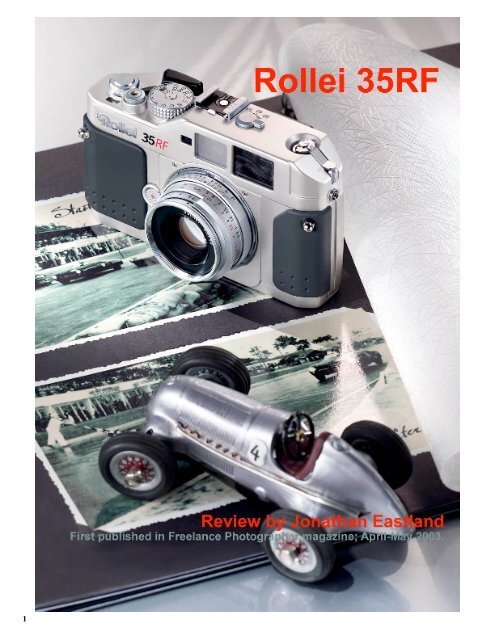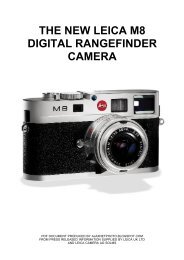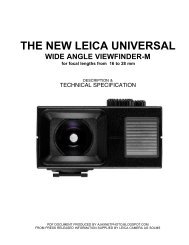ROLLEI 35RF PDF WORK.cwk - AjaxNetPhoto
ROLLEI 35RF PDF WORK.cwk - AjaxNetPhoto
ROLLEI 35RF PDF WORK.cwk - AjaxNetPhoto
You also want an ePaper? Increase the reach of your titles
YUMPU automatically turns print PDFs into web optimized ePapers that Google loves.
SUBJECT new Rollei <strong>35RF</strong>.<br />
DATE January 2003<br />
REPORTER Jonathan Eastland.<br />
Reprinted as reviewed in Freelance Photographer magazine; April-May 2003, with some extra illustrations.<br />
<strong>ROLLEI</strong> <strong>35RF</strong><br />
<strong>ROLLEI</strong> <strong>35RF</strong>; FRONT VIEW, BODY FITTED WITH SONNAR F/2.8, 40MM AND SPECIAL TRIGGER WINDER.<br />
Cosina's apparently relentless push into the 35mm 'classic' camera market was bound, sooner or later, to persuade others in the business<br />
that perhaps, after all, the market was not as washed up as the many digital pundits would have the world believe.<br />
Rollei Fototechnic of Braunschweig in Germany, for long the manufacturer and purveyor of one of the world’s best known and arguably,<br />
best loved, cameras, the twin lens Rolleiflex, recently struck a deal with Cosina, the result of which enables Rollei to market the<br />
Voigtlander Bessa R in alternative attire.<br />
Launched at photokina 2002 as the Rollei <strong>35RF</strong> complete with 40mm f/2.8 Zeiss Sonnar HFT standard lens, the kit retails at £1395.00.<br />
Not as much as the thumping two grand being asked for a new Leica MP body, but an amount substantially more than the cost of a<br />
standard Bessa R fitted with a Voigtlander 35mm f/2.5 'Pancake'.<br />
A glance is enough to confirm the origins of the Rollei <strong>35RF</strong> body. With few exceptions - the Leica-M bayonet lens mount being the<br />
most prominent - it has all the hallmarks of a Bessa R body. Only the decor, a tough, sprayed and baked-on silver paint for the die cast<br />
alumnium top, bottom and front plates in addition to its comfortable to-the-touch-non-slip grey rubber composite panel grips and Rollei<br />
<strong>35RF</strong> bright metallic polished name, differentiate it from Mr Kobayashi's regular babes.<br />
2
<strong>ROLLEI</strong> <strong>35RF</strong> FITTED WITH SPECIAL TRIGGER WINDER.<br />
The <strong>35RF</strong> also differs from the Voigtlander version in having fitted to its rangefinder viewing system a set of bright line frames covering<br />
the initial objectve selection offered by Rollei of 40mm, 50mm and 80mm. The frames are activated by turning a click-stopped lever on<br />
the top plate, there being no linkage in the lens mount to automatically project the required frame as a lens is mounted.<br />
The camera is fitted with the standard Voigtlander Bessa-R vertical run laminar multi bladed focal plane shutter speeded from 1s through<br />
to 1/2000ths + brief time setting 'B' and flash synch via hot-shoe or pc socket at 1/125ths or slower. There is a definate 'clack', much like<br />
the sound of a Nikon FM2 without the mirror noise, as the shutter is released. During the review period of several weeks, I found my<br />
reluctance to use the camera for the kind of street and people photography I use my Leica's for, was based more or less on the one factor of<br />
a higher noise level than I am used to. After an initial enthusiastic start, I was soon aware of heads turning in my direction whenever the<br />
camera was used, and often, not even in the close proximity of others.<br />
3
ABOVE; <strong>ROLLEI</strong> <strong>35RF</strong> -THE CLEAN TOP PLATE LAYOUT.<br />
I tried to maintain a pragmatic view on this, arguing silently for those who cannot afford the engineering quality of a Leica, but who want<br />
a 35mm rangefinder camera with a bult-in light meter and trigger wind facility, there are not many options. It's this, a Konica Hexar RF<br />
or something older.<br />
The combined view/rangefinder of the Rollie <strong>35RF</strong>/Bessa-R works well, giving a bright and contrasty image, though the lozenge shaped<br />
bright patch for the distance measuring is too small and not really contrasty enough for a lot of scenes affected by strong side and back<br />
lighting. The viewfinder also suffers from flaring in strong point source light conditions such as may be encountered in a theatre and this<br />
may have the effect of momentarily nullifying effective use of the rangefinder bright spot .<br />
Setting the film ISO employs a lift-and-turn collar on the shutter speed dial; easily accomplished once the film advance lever is moved<br />
out of the way. However, I found setting the film speed accurately a minor bind, even with good reading glasses. The window and the<br />
film speed markers on the secondary dial are just a wee bit on the small side. Center-weighted TTL average metering with an EV range of<br />
1-19 is activated by lightly pressing the shutter, a function which also checks battery power. Correct-exposure display and warnings<br />
against over or underexposure are user-friendly employing +/- triangles and a circular red LEDs. Somewhat oddly perhaps, these LEDs<br />
glow red through the range/viewfinder light gathering window on the camera front when the meter is activated.<br />
Cosina's design philosophy for the Rollei <strong>35RF</strong>, like their Bessa bodies, appears to borrow some features from older mechanical cameras,<br />
incorporating them into a neat and practical package. The focal length frame selector bears a vague resemblance to the same feature on old<br />
Kristall 35 cameras; the rapid film rewind lever crank looks very old Canon. The film advance and shutter arming lever is similar to a<br />
design first seen on 1970s Olympus OM cameras and Cosina has used Yoshihisa Maitani's clever visual device featured on the OM1 to<br />
lower the apparent height of the camera by adding a break in the contour line of the top plate. In the Rollei/Bessa-R, the break features<br />
only on half the top plate, but it nonetheless assists in effecting apparent smallness.<br />
My overall impression of the <strong>35RF</strong> is that it works well, does the task required of it competently but lacks the engineering refinement of<br />
more expensive brands and some older 1950s and 60s cameras. It may be knit picking, but the lever component of the rapid film rewind<br />
of the Rollei looks as if it has been pressed from a metal flat in a not very accurate die.<br />
So what is it that warrants the considerably higher retail price of this model compared with the few hundred pounds necessary to purchase<br />
a bog standard Bessa R and screw threaded 35mm Voigtlander Panacake lens, both of which have been very well received in just about<br />
every photographic journal?<br />
The fitted-as-standard Rollei Sonnar f/2.8 40mm HFT lens is what makes the substantial difference, allowing that is, for a reasonable<br />
increase in manufacturing customising cost of the <strong>35RF</strong> body over the Bessa R. The outward appearance of the 40mm Sonnar objective is<br />
certainly finely engineered and finished, as one might expect from a company of Rollei's calibre.<br />
There has been some internet debate as to who actually makes the lenses for this camera. The 40mm is a five element, four group Zeiss<br />
design, manufactured and assembled under licence at Rollei's Braunschweig facility using German Schott glass, according to a statement<br />
from Maike Otto at the factory. Both the 50mm and the 80mm will be made in the same plant.<br />
4
All three objective designs are based on models used for other older Rollei products but as I was only able to review the 40mm, a little<br />
history may be useful at this juncture.<br />
ABOVE; <strong>ROLLEI</strong> <strong>35RF</strong> 40MM SONNAR - 2/3RDS CROP FROM WHOLE FRAME. KODAK EBX 100 ISO, 1/125TH SEC @ F8, CENTRE WEIGHTED<br />
UNADJUSTED METERING.<br />
The 40mm f/2.8 Rollei HFT Sonnar first appeared on the Rollei 35S and SE miniature 35mm cameras from 1974. An f/2.3 version<br />
appeared on the Rollei XF 35 model. But this camera was no where near as successful as the 35S type that was later reissued under the<br />
Rollei 'Classic'guise. The original Sonnar 40mm was without doubt, a superb example of optical design, having the capacity to produce<br />
sharp and contrasty prints up to 16 X 20 inches. I used a 35SE for several years and always rued the day I sold it.<br />
Almost thirty years later, the same design using current glass and coating technology, held the promise of similar expectation in its<br />
ability to produce crisp, snappy and well resolved images. I was not disappointed.<br />
Today, 40mm would not normally be my focal length of first choice; I do prefer the slightly wider angle offered by a 35mm. But, this is<br />
perhaps just a visual notion; I used the old Rollei 35SE for countless Parisian night shots over a couple of winters and when Olympus<br />
produced their dimunitive 40mm f/2 pancake lens, it became a regular companion on street forays for several more years. There is<br />
something about the 40mm angle of view; perhaps comparitively, its ability to manifest a visual effect with a different spatial perspective<br />
closer to that obtained with a 75mm on a 6X6cm medium format than the more normal 80 - 100mm.<br />
RAIL TRACK PICTURE NEXT PAGE;<br />
<strong>ROLLEI</strong> <strong>35RF</strong>/40MM SONNAR. RAW SCAN ADJUSTED FOR LEVELS AND COLOUR CORRECTION AS BOTH WERE WAY OUT FROM THE ORIGINAL<br />
KODAK EBX TRANSPARENCY. FOCUS POINT AT END OF VERTICAL SLEEPERS.<br />
5
By the end of a cold bright day in the northern French village of Cassel and its environs, I had quite got back into the swing of seeing the<br />
40mm vista. So much so that I switched the Sonnar over to a Leica MP-6. Using almost all of the window in which the bright line frame<br />
for the 50mm was projected, permitted fairly accurate framing.<br />
Rollei intend to offer this lens independently at £649.95 which is little more than the current list price of the chrome Leica 50mm f/2.8<br />
Elmar collapsible. Indeed, breaking into the Leica market is clearly the strategy; all three lenses have Leica L39 screw threads fitted with<br />
M bayonet adapters, enabling use on any M camera as well of course, without the adapter, on any L39 screw camera. This may work for<br />
the 50mm and the 21mm when it comes, but the other two really need accessory veiwfinders if they are to be used with any accuracy on<br />
anything other than the Rollei <strong>35RF</strong> body.<br />
ABOVE; <strong>ROLLEI</strong> <strong>35RF</strong>/ 40MM SONNAR 2.8 HFT. FILM; KODAK EBX. FULL FRAME SCAN ON NIKON 4000ED TO 18MB. THIS FRAME CROPPED TO<br />
APPROX 2/3RDS ORIGINAL IMAGE. RAW SCAN. NO LEVELS APPLIED. NO U/S MASK. SPECULAR HIGHLIGHTS ARE WELL HANDLED BY THIS LENS<br />
WITH NO APPARENT FLARING. GOOD COLOUR DETAIL IN SHADOW AREAS. SLIGHT MAGENTA CAST IN NEUTRAL AREAS. VERY SHARP. ALL<br />
FRAMES METERED WITH <strong>ROLLEI</strong> <strong>35RF</strong> CENTRE WEIGHTED TTL METER SET AT 100ISO AND BALANCED FOR VIEWFINDER 'CORRECT' DISPLAY.<br />
RESULT IN MOST CASES IS ABOUT 1/3RD STOP UNDER.<br />
The 40mm Sonnar sample is well made. There is an aesthetic difference between this and say a chrome finished Leica 50mm Summicron,<br />
but the engineering of the Sonnar is, from an outward perspective at least, just as accomplished as the latter. The aperture ring is click<br />
stopped at full and half values; it is serrated for about 75% of its circumference allowing rapid and positive finger tip control. The focus<br />
ring is fitted with a finger grip and operates very sweetly; and the lens is heavy, which indicates Rollei have not spared on the use of fine<br />
metals for the barrel manufacture. It comes fitted with a natty screw-over lens hood and velvet rim lined metal cap.<br />
In the past, Rollei have produced several superb professional level cameras, both highly specified and highly regarded medium format and<br />
35mm tools. The current Rollei 6000 series, much underrated in this country, is a prime example of a superbly manufactured camera.<br />
Earlier attempts with the smaller but similar 2000 and 3000 series of the 1980s were equally well engineered, but somehow lacked wide<br />
appeal. Only the 35S cameras took off with more than two million of the different models manufactured.<br />
Will the <strong>35RF</strong> do as well? I somehow doubt it. But this opinion ought to be qualified. The Cosina body provides a relatively<br />
inexpensive means for the company to dip a toe in the apparently burgeoning 35mm rangefinder market place while adding time proven<br />
and first class objective alternatives to the existing Voigtlander, Konica and Leica choice. If these are successful, which I am hedging they<br />
will be if competetively priced, look out for a 21mm or something wider. For now, Rollei Fototechnic has no plans to design and build<br />
its own 35mm rangefinder body.<br />
For the image quality appraisal, I used the 40mm Rollei Sonnar with its factory supplied adapter ring mounted on a Leica M6TTL camera<br />
which enabled comparisons to be made between a much earlier screw thread 35mm f/3.5 Leitz Summaron and a late 1980s 35mm f/2<br />
Summicron, this length being probably an alternative choice for users and closer to the straightforward Sonnar design - no modern<br />
aspherical (and much more expensive) elements included, than the longer 50mm.<br />
7
ABOVE; WHOLE 35MM FRAME AREA OF OBJECT FOR SHARPNESS/DETAIL RESOLUTION APPRAISAL. KODAK 400 PORTRA UC SAMPLE SCANNED<br />
AT 4000ppi ON NIKON 4000ED FILM SCANNER PRODUCED A FILE OF 65.3MB FROM WHICH DETAIL IS SHOWN ENLARGED BELOW.<br />
ABOVE.; LENS: 1959 LEICA-L SCREW 35MM F/3.5 SUMMARON WITH LEITZ ADAPTER ON M6TTL 1/1000th S @ f/4.5. SMALL SECTION FROM<br />
WHOLE FRAME SCANNED AT 4000ppi. RE-SIZED TO 8.5CMS @ 300ppi. LIGHTENED 20%. 400 PORTRA GRAIN STRUCTURE CLEARLY VISIBLE,<br />
RESOLVED DETAIL AND SHARPNESS V.GOOD, CONTRAST LOW.<br />
8
ABOVE;; LENS: 1988 E.LEITZ/WETZLAR SUMMICRON-M 35MM F/2 SUMMICRON ON M6TTL. 1/1000TH S. @ F/5.6. SAME SCANNING DETAILS<br />
AS PREVIOUS IMAGE. NO U/S FILTER APPLIED TO ALL THREE. THIS IMAGE SHOWS MORE DETAIL THAN (1) BUT STILL LESS THAN FOR THE<br />
<strong>ROLLEI</strong> 40MM SONNAR. EDGE ACUTANCE IS SOFT COMPARED WITH HARDER EDGED SONNAR. SUMMICRON CONTRAST IS ALSO LOWER.<br />
ABOVE; LENS: NEW 2002 <strong>ROLLEI</strong> 40MM F/2.8 SONNAR HFT MADE BY <strong>ROLLEI</strong> IN GERMANY WITH SCHOTT GLASS FITTED TO M6TTL WITH<br />
<strong>ROLLEI</strong> SUPPLIED NON LEICA ADAPTER.1/1000TH S @ F/4.5. SCANNING DETAIL SAME AS FOR THE LEITZ SUMMARON ABOVE. DENOTES A<br />
SIGNIFICANT IMPROVEMENT IN RESOLVING ABILITY WITH DETAILS OF THE RIGHT HAND DISC CLEARLY VISIBLE. MUCH SHARPER OVERALL,<br />
HIGHER OVERALL CONTRAST.<br />
The results were interesting, if a little predictable in the case of the 1950s vintage Summaron. The 35 f/2 Summicron provides the benefit<br />
of an extra stop in its maximum aperture - compared with the 40mm Sonnar, and a quite different, slightly softer image. There was no<br />
doubting the Sonnar's ability to resolve fine detail crisply and clearly, even when using Kodak's new Portra 400 UC at the larger<br />
apertures. Slower speed emulsions such as the Kodak EBX I used in France rendered a typically cold neutral Zeiss effect but clearly, the<br />
images contained stacks of minute detail over a wide tonal range.<br />
9
Current Rollei <strong>35RF</strong> lenses:<br />
(from Rollei press release.)<br />
Sonnar 40mm f/2.8 HFT<br />
The famous candid lens of the legendary Rollei 35, with its ideal focal length for outdoor and indoor photography. A lens ideally suited<br />
for news photography. Its initial aperture of f/2.8 gives it a wide margin for shooting in low light with excellent focusing results. (5<br />
elements in 4 group design.) Price £649.95.<br />
ABOVE; <strong>ROLLEI</strong> <strong>35RF</strong> - 40MM SONNAR F/2.8. CONTRE JOUR. THE LENS HANDLES BACK AND SIDELIGHTING VERY WELL WITH NO OBVIOUS<br />
FLARING OR CHROMATIC ABERRATIONS. DYNAMIC RANGE IS EXCELLENT.<br />
RAIL BARRIER ILLUSTRATION, NEXT PAGE;<br />
<strong>ROLLEI</strong> <strong>35RF</strong>/40MM SONNAR. AUTO LEVELS APPLIED, NO OTHER ADJUSTMENTS. FILM; KODAK EBX 100 ISO. 1/125TH S @ F/8-11. EXCELLENT<br />
ACROSS THE FRAME SHARPNESS AND TYPICAL ZEISS COOL COLOURING. RATHER MORE MAGENTA THAN I LIKE BUT THIS IS A COMBINATION<br />
OF LENS COATING, FILM CHOICE AND IN WINTER WHEN THIS SHOT WAS MADE, A NATURALLY HIGH LEVEL OF MAGENTA LIGHT IN THE<br />
NORTHERN HEMISPHERE.<br />
10
Planar 50mm f/1.8 HFT<br />
The typical standard lens, with outstanding correction and sharpness, light in weight and very compact. A focal length well adapted to<br />
available-light photography. Well-suited for a wide range of subjects, from interiors up to half-length portraits, with or without artificial<br />
lighting or flashlight, even in unfavorable lighting conditions. (in preparation for the first half of 2003) (7 elements in 6 group design.)<br />
(No price yet.)<br />
Planar 80mm f/2.8 HFT<br />
A medium focal length for portraiture, also well-suited for landscape details and candid shots from a certain distance. In medium-format<br />
photography, it became famous for its excellent flatness as the standard focal length of the well-known twin-lens Rolleiflex. Experts<br />
consider it one of the best available lenses for creative photography. (5 elements in 4 group design.) (No price yet.)<br />
Technical specifications<br />
Rollei 35 RF<br />
Negative size: 24 x 36 mm on size 135 film<br />
Lens mount: M bayonet<br />
Shutter: Vertical-travel laminar metal focal-plane shutter; 1 s - 1/2000 s and B<br />
Camera body: Made of die-cast aluminium<br />
Focusing: With coupled coincidence-type rangefinder<br />
Exposure display: Overexposure warning, correct exposure, underexposure warning<br />
Metering system: Center-weighted TTL average metering upon light depression of shutter release<br />
Metering range: EV 1 - 19 (ISO 100/21∞; 1 s at f/1.4; 1/2000 s at f/16)<br />
Flash synchronization: PC terminal and hot-shoe contact; sync speed 1/125 s and slower<br />
Film advance: By one or several turns of advance lever; double-exposure lock; optional T Winder can be attached to<br />
bottom plate<br />
Film rewind: By crank in rewind knob<br />
Frame counter: Additive, with automatic reset when camera back is opened<br />
Film-speed setting range: ISO 25/15∞ - 3200/36∞ in one-third increments<br />
Exposure-meter power supply: Two 1.5V alkaline-manganese (LR44) or silver-oxide button cells (SR44)<br />
Dimensions (mm/w x h x d): 135,5 x 81,0 x 25,5<br />
Finish: Metal cover plates silver-finished<br />
Copyright:Jonathan Eastland, February 2003.<br />
This .pdf document has been prepared on an Apple Mac computer. For best printed viewing it should be printed<br />
on a good quality coated brilliant white paper.<br />
Other .pdf documents featuring camera reviews by Jonathan Eastland are available on the Ajaxnetphoto.com<br />
website at >www.ajaxnetphoto.com< and the Ajaxnetphoto.com News & Information blog which can be found at<br />
>www.ajaxnetphoto.blogspot.com< subscribe to receive continuous updates of new postings on photography<br />
related matters on this popular site.<br />
Buy photographs and prints on-line at >www.ajaxnetphoto.com/printordertemp.htmlwww.ajaxnetphoto.com/editions.html






